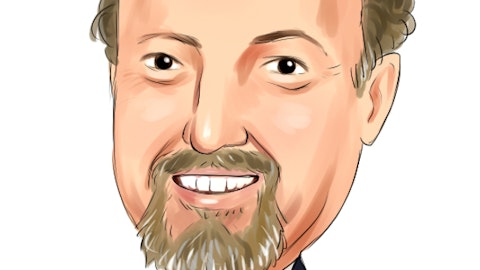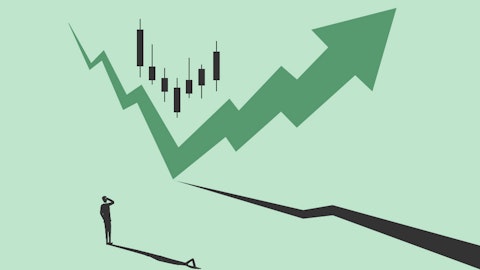Halliburton Company (NYSE:HAL) Q3 2023 Earnings Call Transcript October 24, 2023
Halliburton Company beats earnings expectations. Reported EPS is $0.79, expectations were $0.77.
Operator: Good day and thank you for standing by. Welcome to the Halliburton Company, Third Quarter 2023 Earnings Conference Call. At this time all participants are in a listen-only mode. After the speakers’ presentation there will be a question-and-answer session. [Operator Instructions]. Please be advised that today’s conference is being recorded. I would now like to hand the conference over to your speaker today, David Coleman, Senior Director of Investor Relations.
David Coleman: Hello! And thank you for joining the Halliburton third quarter 2023 conference call. We will make a recording of today’s webcast available for seven days on Halliburton’s website after this call. Joining me today are Jeff Miller, Chairman, President and CEO and Eric Carre, Executive Vice President and CFO. Some of today’s comments may include forward-looking statements reflecting Halliburton’s views about future events. These matters involve risks and uncertainties that could cause our actual results to materially differ from our forward-looking statements. These risks are discussed in Halliburton’s Form 10-K for the year ended December 31, 2022, Form 10-Q for the quarter ended June 30, 2023, recent current reports on Form 8-K and other securities and exchange commission filings.

An aerial view of an energy refinery, with massive tanks and piping defining the landscape. Editorial photo for a financial news article. 8k. –ar 16:9
We undertake no obligation to revise or update publicly any forward-looking statements for any reason. Our comments today also include non-GAAP financial measures. Additional details and reconciliation to the most directly comparable GAAP financial measures are included in our third quarter earnings release and in the quarterly results and presentation section of our website. Now, I’ll turn the call over to Jeff.
Jeff Miller: Thank you, David, and good morning, everyone. Halliburton delivered an impressive third quarter. Our margin strength demonstrated the power of our strategy. I am pleased with the stability of our North America business and the profitability of our international growth. Let’s jump right into the highlights. Total company revenue increased 8% year-over-year, while operating income grew 23%. International revenue grew 17% year-over-year with strong activity in all geographic markets. North America revenue was roughly flat year-over-year and down 3% sequentially. Our completion and production division grew revenue 11% year-over-year, while margins expanded 280 basis points, margins expanded 105 basis points sequentially driven by international operations, while North American C&P margins remained approximately flat the last quarter.
Our drilling and evaluation division grew revenue 4% year-over-year, while margins expanded 168 basis points. Finally, we generated $874 million of cash from operations, $511 million of free cash flow and repurchased approximately $200 million of common stock and $150 million of debt during the quarter. To our over 45,000 employees globally. Thank you for another outstanding quarter, you executed our strategy and delivered excellent financial results. I’ll begin with what I see in the macro environment. Reliable and affordable energy remains at the very center of global economic growth and security. The most recent world oil outlook from OPEC expects 10 million barrels of oil demand growth before the end of the decade and further demand growth through 2045.
Maintaining production while adding incremental supply requires meaningful long-term investment in both short and long cycle barrels to meet demand. This challenge is reflected in our customers’ activity levels and future development plans. Consistent with this outlook, we expect continued demand growth for oilfield services in 2024 and beyond. Everything I see today strengthens my conviction in the long duration of this upcycle. Against this backdrop, I believe the execution of our strategy will deliver strong free cash flow, growing margins and more cash return to shareholders. Starting with North America, Halliburton performed exactly as I expected, delivering our strategy to maximize value in North America. Our North America business has changed.
Despite the U.S. rig count decreasing around 20% since Q4 of 2022, Halliburton delivered strong revenue and margin performance during this period. That’s quite a different result from what Halliburton would have delivered in prior cycles. Since 2015, we changed our strategy. We changed our operating model, and the market structure changed. Our strategy in North America is to maximize value. Executing this strategy made many of our decisions over the last few years crystal clear, including our decision to invest in differentiated and value-added technologies, such as our Zeus electric fleets, automation, and our fiber optic downhole fracturing diagnostics. We know that in a competitive market to capture value, you must first create value. Our decision to derisk returns and maximize free cash flow by only building fracturing equipment under long-term contracts.
And finally, our decision to retire old equipment when returns are not sufficient rather than to pursue market share. Maximizing value means just that, do the things that improve returns and stop doing the things that lower them. Next, we fundamentally changed our operating model. We removed $1 billion of fixed costs from our business in 2020. Those cost reductions were structural and remain in place today. As a result, today, our cost structure is more variable and less fixed. And it’s one of the reasons we have the flexibility to pursue returns rather than market share. Our commitment to continuous improvement drove significant changes in the way we work, which delivered efficiency improvements in our operations. This resulted in a 68% improvement in hours pumped per crew in just the last four years.
Finally, the E&P and services markets fundamentally changed. Today the market is more consolidated, more focused on returns, and more focused on free cash flow generation. We see the benefits of this change. Customers assign value to technology and efficiency, and the service industry is rewarded for returns rather than growth. Never before as the success of our North America business been better aligned with the success of our customers who make significant long-term investments in the region. I expect the combination of our value proposition and strategy will deliver a more profitable business that generates more free cash flow for years to come. Now let’s turn to international markets, where Halliburton’s revenue grew 17% compared to the same quarter of last year.
In the third quarter, we saw activity increase in both divisions, though particularly in our completions and production division. Our results clearly demonstrate Halliburton strong global competitiveness in both divisions and the successful execution of our strategy for profitable international growth. We execute our profitable growth strategy through our differentiated technology offerings, selective contract wins, and our unique collaborative approach with customers, all of which build on our foundation as a leader in service quality and execution. I expect the market for oilfield services will further tighten as asset intensive offshore activity increases. More importantly, I expect that pricing returns will serve as the mechanism to allocate scarce equipment.
This is a great market for Halliburton to execute its strategy for profitable international growth. I’m excited about our international business and we’re on track to deliver high teens year-on-year growth in 2023. Looking ahead, 2024 is coming into view and I expect to see international activity again directionally higher, with market growth in the double-digit range. I’d like to take a few minutes and talk more about our global offshore business. Let me start with some color. Offshore represents more than 50% of our business outside of North America land. About 25% of our C&P revenue is generated offshore. More than 40% of our D&E revenue is generated offshore. All of our regions contribute materially to our offshore revenue. All of our product lines operate offshore and Halliburton leads in many well construction product lines key to offshore development.
Customers choose Halliburton because we collaborate and deliver impactful results. The combination of our leading product lines, and our collaboration from design through well delivery is what drives superior results for our customers. One example is in Norway, where according to IHS Rushmore data, the Aker BP Alliance where Halliburton provides well construction services consistently represents the top quartile of drilling performance. This performance matters even more in a market where offshore rig rates and spread costs are rising. With our customers, we deliver some of the most technically complex wells in our industry. We provide leading solutions in many areas including high pressure, deepwater completions, complex multilateral junctions, ultra deep reading LWD tools, narrow margin drilling fluids and tailored lightweight cement.
These solutions enable our customers to efficiently and reliably develop their offshore reserves and maximize the value of their assets. Execution of our value proposition has created a strong offshore business underpinned by efficiency and differentiated technology. Our ability to compete in all parts of the offshore business including exploration, development and intervention has never been better. Let me close with this. I’m both excited and confident in the outlook for our business, the duration of this upcycle the clarity and depth of our strategy and the strength of our execution. Now I’ll turn the call over to Eric to provide more details on our financial results. Eric?
Eric Carre: Thank you, Jeff, and good morning. Our Q3 reported net income per diluted share was $0.79. Total company revenue for the quarter was $5.8 billion flat sequentially, while operating income was $1 billion a sequential increase of 3%. Operating margin for the company was 17.9% in Q3, a 207 basis point increase over Q3 2022. Beginning with our completion and production division, revenue in Q3 was $3.5 billion flat sequentially, while operating income was $746 million, an increase of 6% sequentially. C&P delivered an operating income margin of 21%. These results were primarily due to increased stimulation activity internationally, higher cementing activity in the eastern hemisphere, and improved completion tool sales globally.
These increases were partially offset by lower pressure pumping services in North America. In our drilling and evaluation division, revenue in Q3 was $2.3 billion flat sequentially, while operating income was $378 million, which was also flat from Q2. D&E delivered an operating income margin of 16%, an increase of 168 basis points over Q3 last year. Sequential changes were driven by higher fluid services in Middle East Asia, and Latin America, and increased wireline activity in Latin America and Europe/Africa. These were offset by decreased drilling related services, lower project management activity and software sales in Mexico. Now let’s move on to geographic results. Our Q3 international revenue increased 3% sequentially. Latin America revenue in Q3 was $1 billion, a 5% increase sequentially.
This increase was primarily due to increased pressure pumping services, and drilling fluids in Argentina, improved completion tool sales in Brazil, and higher project management and drilling related services in Colombia and Ecuador. Partially offsetting these increases were lower software sales, decreased project management and lower well construction services in Mexico. Europe/Africa revenue in Q3 was $734 million, a 5% increase sequentially. This increase was primarily driven by improved well construction services, higher completion tool sales and improved wireline activity in Norway, and higher completion tool sales in the Caspian area. These were partially offset by lower activity in Africa across multiple product service lines. Middle East Asia revenue in Q3 was $1.4 billion, which was flat from q2.
These results were driven by higher well construction in Iraq, increased drilling related services and completion tool sales in Qatar, and higher pressure pumping and fluid services in Asia. These were offset by decreased activity in multiple product service lines in Kuwait, and India and lower drilling, testing and well intervention services in Asia. In North America, revenue in Q3 was $2.6 billion, a 3% decrease sequentially. This decline was primarily driven by decreased pressure pumping services in U.S. land, and lower well intervention services in the Gulf of Mexico. Partially offsetting these decreases was improved completion tool sales in the Gulf of Mexico. Moving on to other items, in Q3, our corporate and other expenses were $64 million.
For Q4, we expect our corporate expense to increase by about $5 million as a result of timing and special items. In Q3, we spent $23 million, or about $0.03 per diluted share on SAP S4 migration, which is included in our results. For Q4, we expect these expenses to be approximately $14 million, which makes our spent approximately $50 million for 2023 as planned. Net interest expense for the quarter was $93 million, which was flat from the prior quarter. For Q4, we expect this expense to remain approximately flat. Other net expense for Q3 was $28 million, primarily related to unfavorable foreign exchange movements. For Q4, we expect this expense to remain approximately flat. Our effective tax rate for Q3 came in at 21%, based on our anticipated geographic earnings mix, we expect our Q4 effective tax rate to remain approximately flat.
Capital expenditure for Q3 were $409 million, we anticipate that for the full year, capital expenditure will be approximately 6% of revenue. Our Q3 cash flow from operations was $874 million, and free cash flow was $511 million. We expect to generate over $2 billion of free cash flow for the full year 2023. Finally, consistent with our capital return policy of returning at least 50% of free cash flow to shareholders, we repurchased approximately $200 million of our common stock during Q3. Additionally, during Q3, we repurchased $150 million of debt. Now turning to our near-term outlook. Let me provide you with some comments on how we see Q4 unfolding. In our Completion and Production division, we anticipate revenue to decrease by 3% to 5% sequentially, while operating margins are expected to decrease 25 to 75 basis points as a result of lower North America land activity due to holidays and lower winter month efficiencies, partially offset by higher year-end completion tool sales.
In our Drilling and Evaluation division, we anticipate revenue to grow by 4% to 6% sequentially, while operating margins are expected to increase 75 to 125 basis points due to seasonal software sales and higher global activity. I will now turn the call back to Jeff.
Jeff Miller: Thanks, Eric. Let me summarize our discussion today. Halliburton delivered an impressive third quarter. Our margin strength demonstrated the power of our strategy. I’m pleased with the stability of our North America business and the profitability of our international growth. Our North America business performed exactly as I expected, delivering our strategy to maximize value in North America. Our international results clearly demonstrate Halliburton’s strong global competitiveness in both divisions and the successful execution of our strategy for profitable international growth. Execution of our value proposition has created a strong offshore business, and our ability to compete in all parts of the business has never been better. And now let’s open it up for questions.
See also 20 Countries with Lowest Rates of Cancer and 20 Highest Paying Countries for Doctors.
Q&A Session
Follow Halliburton Co (NYSE:HAL)
Follow Halliburton Co (NYSE:HAL)
Operator: Thank you. [Operator Instructions] Our first question is from Dave Anderson with Barclays. Please proceed.
Dave Anderson: So Jeff, the duration story internationally is very compelling with the capacity expansion in Middle East, offshore FIDs and offshore work that you were talking about. So I wonder if you could talk a little bit about how that translates into the cadence of international growth over the next 12 to 24 months. International sale looks a little sluggish this quarter, MENA was flat. I know Kuwait’s been a bit slow, but I’m just wondering, should we start to see the region accelerate in 2024?
Jeff Miller: Yes. Thank you, Dave. And look, I expect that it will. And I’ve talked about growth for 2024 double digits. But to frame that, our strategy is profitable international growth. And we’ve grown 20% in ’22, high teens this year, double digits next year. So I’m comfortable with the growth and expect we will continue to see strong growth, certainly above market growth. But we’re doing that while improving margins and expanding margins. And so I think that our strategy is crystal clear around what we’re going about. There’s plenty of market there to do that and expect we will continue to do that in ’24 and beyond.
Dave Anderson: And if I could just shift over to kind of one of the big topics out there is M&A, Chevron, Exxon, [indiscernible] EPs in North America. Can you talk a bit about what this means to Halliburton. On the one hand, I’m thinking this should provide you really significant visibility on your development programs. On the other hand, perhaps your pricing levers might be a bit compromised if you only have a handful of large customers. Could you just kind of big picture, talk about what’s leading to your business, please?
Jeff Miller: Yes. Big picture, good for Halliburton. I think it does a couple of things what we’re seeing. Certainly, it demonstrates the long-term importance of oil and gas and more specifically, worldwide and more importantly, the long-term importance of North America. I mean what we’re seeing are big players that take a really long view, and these are the kind of customers that clearly work through cycles. And so I think we’ll see a much more stable North America I really like our position with our customer mix today is clearly biased. Most of our work is with very large privates and publics. And so I like our position there. And then more importantly, these are customers that care about the kinds of things we work on at Halliburton.
So when we work on, I think important things like productivity, efficiency and recovery. And we talk about all 3 of those in our business. And I think we’re unique in the way that we approach those. So I think it will be good for Halliburton.
Dave Anderson: And what this accelerated adoption of e-frac, you think, with both of those two customers?
Jeff Miller: Look, I think that’s exactly the kind of tool that customers like this want to have in their hands, and we’re seeing pretty good adoption. I would say north of 60% of our business today are repeat customers. So these aren’t science projects. This is things that are being baked into workflows.
Operator: It comes from the line of Neil Mehta with Goldman Sachs. Please proceed.
Neil Mehta: One of the notable things about the quarter was the return of capital, the $200 million of share repurchases. Maybe you could just frame out for the market, how you’re thinking about your share repurchase strategy and setting us up for your framework as we go into 2024?
Eric Carre: Yes. Good morning, Neil. So look, dividends and it’s clearly part of our return strategy. But directionally nothing has changed in our overall policy of returning about 50% or over 50% of our free cash flow to shareholders. I mean right now, we like the flexibility that buybacks give us, and we’re thinking similarly as we get into next year. If we look at what we’ve done this year, we’ve returned $1 billion already to shareholders so far this year. As our business continues to grow and our margins continue to improve as well. I would expect that these overall returns would be higher as we get into 2024.
Neil Mehta: Okay. That’s helpful. And we appreciated a little bit of color on 4Q, but I was wondering if you could kind of unpack some of that guidance a little bit more, talk about what you’re thinking about from a regional perspective? And any comments that we need to keep in mind as we think about the next quarter sequentially.
Eric Carre: Yes. I think, Neil, we’re typically giving guidance on a division basis, which is the way we report numbers, and I think we will leave it at that.
Jeff Miller: Well, maybe just a little bit of color around North America, we’re going to see some seasonality as we’ve described it in the last few years. We’ve had really strong tailwinds into Q4. I would expect this year, we’ll see what I would describe as more normal seasonality. And then, clearly, there will be completion tools and other sales in there that help internationally, we’ll probably see software sales in Q4, probably Q1 and more activity and more pricing. And hopefully, that’s helpful color.
Operator: And it comes from the line of James West with Evercore ISI.
James West: If I could, I’d love, Jeff, as you would talk a little bit about the competitive environment that you see in front of you now. It seems to me that we’ve had a big change in the overall market over the last decade or so with one competitor kind of dropping back, one moving into other non-oil and gas businesses and so kind of leaving the oil and gas side is somewhat about a duopoly for yourself and your main competitor but both of you are focused on returns. And so it’s not a pricing fight or a market share fight, it’s kind of, hey, we’re in the same game, let’s generate cash, let’s generate free cash flow to get back to shareholders. Let’s get pricing up for returns. Is that kind of how you see ’24, ’25, ’26 unfolding or am I mistaken in my view, we’ve got a different competitive environment.
Jeff Miller: Well, James, it’s highly competitive in the marketplace. And we are absolutely focused on our strategy at Halliburton and I’ve been really clear about that. And so independent of what anyone does in the marketplace from a Halliburton standpoint, we are maximizing value in North America. We are growing profitably internationally and driving capital efficiency. And I think some of the cash flows that you see and improving cash flow that you see is driven out of our fundamental strategy to develop R&D that is more capital efficient. And so this has been a strategy underway for probably 5 or 6 years, maybe longer. And today, we’re seeing the fruits of that. But from a competitive perspective, highly competitive marketplace and we’re always continuing to lower total cost of ownership for our customers and also drive the three things.
And the outcome of that is clearly better free cash flow, more cash flow return to customers, but it starts with that basic strategy.
James West: Right. Got it. Okay. And then, if we think about North America as this cash machine, as I think about it for you guys, with some seasonality here in the fourth quarter, do you anticipate pricing degradation? Or do you think that everything kind of holds up here and we’re in just kind of this continued harvesting period.
Jeff Miller: Well, look, I think that North America, as we look forward into ’24, the consolidation activity that we’ve seen is clearly a demonstration of how important North America is. In the kind of environment that we’re in today, it’s hard for me to imagine operators who want to be smaller rather than bigger given the $85, $90 commodity price. So I think that will drive certain amount of activity up from here. From our perspective, we see largely a steady market from as you described it, just partly because we are focused on retiring diesel fleets and transitioning to electric. We’ve got a very clear strategy around North America. And we believe that our service quality performance and technology, those get better every day, and they drive margins.




